| 1 | Central America’s most feared snake |
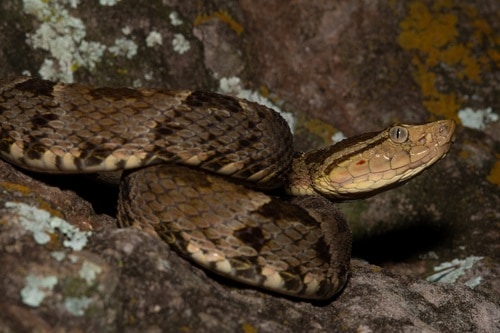
In ancient times, if an army wanted to trek through Central America on foot to reach the glorious possibilities beyond, there was one major obstacle blocking them. It wasn’t towering mountain ranges, deserts or even formidable enemy walls and fortresses. No, it was the fact that almost every inch of land was controlled by the fer-de-lance, AKA Bothrops asper. This is a name that lives in infamy, as the fer-de-lance is among the most dangerously venomous and unpredictable snakes in the world.
The fer-de-lance’s realm begins in southern Mexico, and passes through 6 of 7 Central American countries, including Costa Rica and Honduras. The only country they’re missing from is El Salvador, and not so coincidentally, El Salvador has the lowest snakebite rate per head. They’re also abundant in Colombia and Ecuador, but are blocked from mainland South America by the Andes mountain range. Here, the closely related but distinct common lancehead (Bothrops atrox) takes over.
Fer-de-lances lack neurotoxins, with a more typical viper profile of haemorrhagins and cyotoxins. Yet these are taken to the absolute maximum, and the venom yield can be gargantuan, at 300-500mg, and occasionally over 1000mg in the largest females. Paralysis is unlikely – most deaths are caused by kidney failure or intercranial haemorrhage.
| 2 | Causes up to 80% of snakebites |
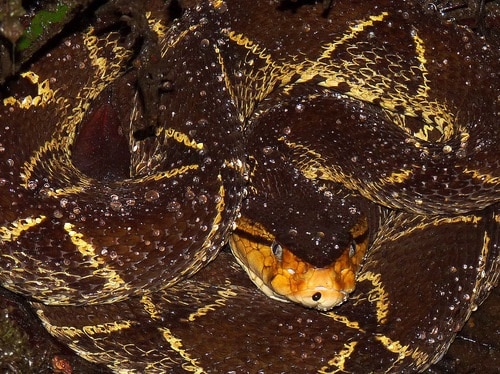
Bothrops asper dominates snakebite statistics in Central America. Among 5550 snakebites in Costa Rica from 1990 to 2000, nearly 80% were inflicted by the fer-de-lance. In parts of Ecuador, they inflict 82%.
In Colombia, the heaviest-affected regions are Antioquia and Chocó, where fer-de-lances cause 50-70% of snakebite. In Venezuela’s Lara state, the figure is 78%. Panama records approximately 2000 snakebites annually, of which 70% are caused by fer-de-lances. In a more recent report on Costa Rican snakebite victims, the species was identified in 295 of cases. 84.5% of these were Bothrops asper. Costa Rica may be their world capital, with all but the towering Central Cordillera mountains home to them. This is mainly a low altitude snake, ranging from sea level to 1300 metres.
The reason for the nightmarish statistics is their habitats. Fer-de-lances are flexible, preferring forests and bushy forest outskirts, but thriving in manmade plantations. They’re abundant in cocoa, shade coffee and banana plantations, where they ambush workers. Their camouflage is incredible, and is tailored to different environments. A fer-de-lance can be almost invisible in the humid Ecuadorian or Costa Rican undergrowth.
Prior to mass antivenom production in the 1950s, 9% of all Bothrops asper bites were fatal. Unlike Brazil, which hosts over 30, the fer-de-lance is the only Bothrops lancehead found in Central America.
| 3 | Exceptionally fast for a viper |
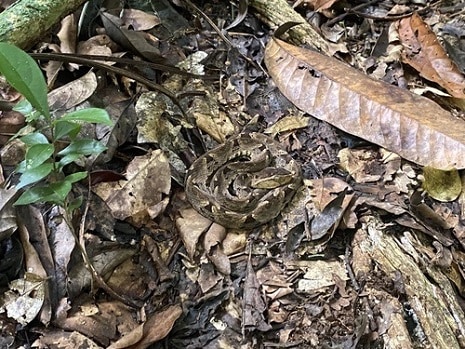
The fer-de-lance is extremely unpredictable, and that only adds to the danger. Depending on their mood, they may flee into bushes, not react, or fly into a hysterical defensive mania.
Typical posture includes a tight toil with their head raised up, and their mouth hanging open. This indicates that an attack is imminent, and when it comes, the speed is exceptional, fasting than a particle launched by a Hadron collider. There’s no clumsy half-hearted lunge – you need exceptional reactions to avoid a fer-de-lance strike. They may be at your feet before you comprehend what’s going on, and they commonly make sudden directional changes when advancing.
They also have a disturbing control over their own venom glands. Fer-de-lances can latch onto your arm and refuse to let go, deliberately pumping 100s of milligrams into your arm, glaring with their vertical pupils, in a scene from your wildest nightmares. Occasionally, they even send flying jets of venom through the air, which is very rare for vipers. This hasn’t been officially documented by scientists, yet there are occasional reports from across Central America.
The positive flipside is that dry bites are surprisingly common with fer-de-lances, injecting no venom, just leaving a gaping wound possibly requiring antibiotics. Bothrops asper has front fangs measuring up to 2cm. As a nocturnal hunter, they’re more likely to turn aggressive at night.
| 4 | Specialises in haemorrhaging |
A 2009 study delved into technical symptoms, compiling many hospital reports of Bothrops asper bites over the decades. Edema (swelling) was easily the most common symptom, at 95% of cases, often manifesting within 5 minutes. Local haemorrhaging affected 34%, often within 30 minutes. This manifested as spontaneous bleeding or ecchymosis, spontaneous bruising. 12% experienced blisters and 10% necrosis, the dying and sloughing off of muscle or skin tissue. These appeared later, usually at 6-8 hours.
At 60-70%, by far the most common systemic symptom was defibrinogenation, when toxins cleave through and destroy fibrin and fibrinogen. The result is completely unclottable blood. Combined with metalloproteases that destroy collagen in blood vessel linings, Bothrops asper venom becomes an unstoppable elixir of haemorrhaging. Even patients receiving antivenom within 30 minutes still experience unclottable blood within 6 hours.
Bothrops asper also targets the clotting agent thrombin, with deficiencies affecting 15-30% of victims. Hypotension affected 10%, and bloody urine and bleeding gums were common among haemorrhaging victims. Recent wounds often re-bled.
| 5 | Destroys the kidneys too |
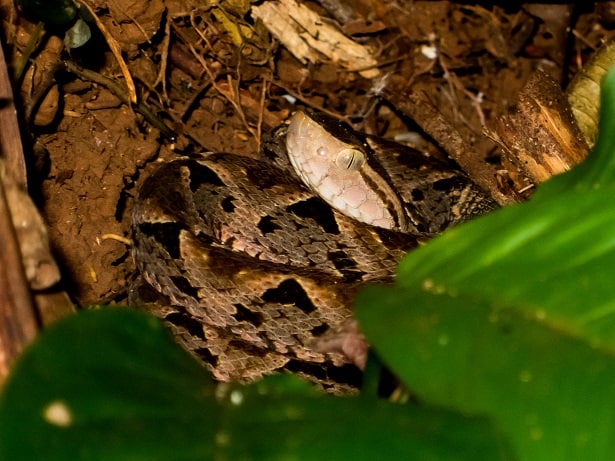
Overall, severe systemic symptoms affected 15% of victims, and severe local effects 10%. But the news isn’t all grim, as 36% experienced only local symptoms, with no systemic effects. Bothrops asper has an unpredictable venom as well as personality.
A 2020 study examined kidney damage, covering many Bothrops family members. With a sample size of 39, acute kidney injury (AKI) affected 38.5% (15) of fer-de-lance victims, and 33.3% (13) of these required dialysis.
Other members were deadly, but not as overwhelmingly so. The jararacussu of dark forests in southeast Brazil had 29 victims tested, with 4 suffering AKI and 2 requiring dialysis. A study on Bothrops moojeni from riverside forests in southern Brazil involved 57 victims, and just 3 suffered AKI. Then a study combining Bothrops moojeni with Neuwied’s pitvipers (southern Brazilian cerrado) involved 292 patients, of whom just 5% experienced acute kidney injury. The closest came with a study on the Caatinga lancehead of eastern Brazil, where 35% of patients suffered AKI, but Bothrops asper was harshest on the kidneys overall.
The study also tested coagulopathy, the disruption of blood clotting, and 79.5% of the 39 fer-de-lance victims were affected, which is close to the 2009 study earlier.
| 6 | Constantly respawning |
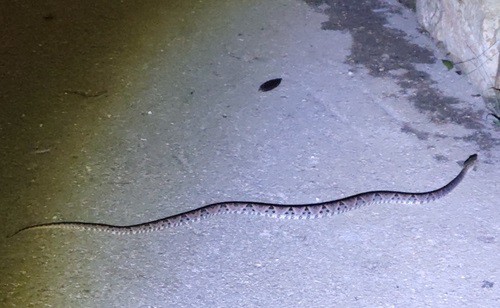
One reason fer-de-lances are so dominant in central America is the giant number of young they lay. A mother can snuggle up inside a small forest hollow, and by the next morning have laid 40 more fer-de-lances, ready to terrorise the forests and potentially produce 40 more each in three years. Not all neonates survive, but with such high numbers, the odds are permanently stacked in favour of the species’ dominance. The record was an 86 from Costa Rica, while 50 is perfectly ordinary.
While scientists disagree, rumours persist in Costa Rica that fer-de-lances are rising in number, fuelled by sensationalist tabloid reports and TV journalists. In reality, it’s thought that the rise of cocoa and coffee plantations is bringing humans into closer contact, creating the illusion of a rise. Fer-de-lances particularly love abandoned agricultural areas where forest regrowth is just beginning, known as “tacotales” locally.
Newborns measure 18-25cm at birth, and their venom is already potent enough to kill. As adults, the average is 100-120cm, but Bothrops asper can occasionally exceed 2 metres. This reptile expert mentioned a review of 350 preserved fer-de-lances by a correspondent of his, stored in museum collections, and the longest measured 2.06 metres.
| 7 | Changes position each night |
Bothrops asper is a committed ambush predator, but are far less lazy than an eyelash viper or South American bushmaster, which can stay motionless for weeks at a time. Bothrops asper uses a hybrid strategy – they stay completely still while hunting, yet move to a new position most days. They often utilise different positions over one night, ranging from 1-4 positions in one study. These mini moves are usually just 5-10 metres, followed by a couple of hours of stillness. Every few days, or weeks, they’ll then embark upon a longer move of 50 metres, to find more bountiful hunting grounds.
Fer-de-lances are surprisingly intelligent, and will manipulate vegetation to their advantage, coiling their tail around a fallen palm, and lifting it while they slide their entire body beneath. Then they sit patiently for hours until a big-eared climbing rat or Central American agouti walks past.
The classic ambush position is a body tightly coiled, and head resting in the centre of the coils, angled upwards at 45 degrees. Bothrops asper is an overwhelmingly nocturnal hunter. In a study from Heredia Province in Costa Rica, 1246 were observed in this ambush position during the night, and only 73 during the day.
| 8 | Particularly loves swamp shores |

Fer-de-lances are creatures of moisture and warmth. In a desert, you’ll never meet one, though you may sink in quicksand and fall into a secret underground rattlesnake citadel instead.
A 2009 study decided to analyse Bothrops asper’s habitat properly. It confirmed what everyone knew: a love of forests, forest edges, and agricultural sites like cocoa and coffee plantations. However, it discovered a particular love of swamps in both males and females. For example, the terrain studied consisted of 17.0% swamps, yet fer-de-lances were detected by swamps 57.4% of the time, when tracked by radio telemetry. They were usually 1-2 metres from the shore, as fer-de-lances aren’t semi-aquatic and rarely enter water. However, they’ll happily cross rivers if they stand in their way. One was observed swimming directly across a river 60 metres in width, multiple times. It rarely spent time in the water outside of these crossings.
Vegetative cover was important for fer-de-lances. They’re occasionally found on urban streets, but in the study, only 0.2% of sightings happened near the scientists’ laboratory, which was stripped of most bushes and plants. Occasionally, the fer-de-lances would embark upon giant movements – one moved 1200 metres in two nights.
| 9 | Diet: mammals, but not exclusively |
The fer-de-lance combines many cunning skills of snakes worldwide, and one is a brightly coloured tail tip, designed for luring in curious rodents. The colour varies by gender – males have a bright yellow tip, and females pink. This tail tip fades into adulthood.
Like most Bothrops lanceheads, the fer-de-lance only eats snakes occasionally. A few have been confirmed, such as the false coral snake (E. bizona), redback coffee snake and Hallowell’s coffee snake. The most detailed diet study so far took place in Ecuador. Across 193 Bothrops asper from museum collections, the diet consisted of 71.01% mammals, 4.3% squamates (lizards/snakes), 15.9% frogs and toads, and 8.7% centipedes, a nicely varied diet, but clearly biased towards mammals. Confirmed prey include…
Mammals: hooded four-eyed opossum, common tapeti, black rat, dusky rice rat, southern cotton rat.
Reptiles: yellow-headed gecko, black spiny-tailed iguana, Central American whiptail.
Amphibians: Forrer’s grass frog, Veragua cross-banded tree frog, Fitzinger’s robber frog.
Birds: blue-black grassquit, bay wren.
The fer-de-lance can swallow prey at least 65% of its own body mass. Meanwhile, a Costa Rican study found a diet of 69% mammals, 10.3% lizards, 10.3% birds, and 6.9% frogs and toads.
| 10 | Many predators and enemies |
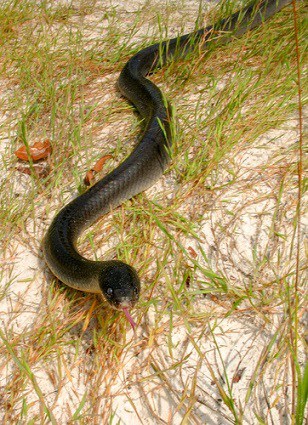
The fer-de-lance is an aggressive serpent which most Central American locals dread meeting. The local rainforest creatures are identical, but there’s a handful of exceptions, chief among them the mussurana (Clelia clelia). This 2 metre constrictor may be the fer-de-lance’s single main predator, and the only rival snake that regularly eats them. They’re completely immune to the venom, as when Clelia clelia serum was given to mice, which were then injected with Bothrops asper venom, they gained total immunity from haemorrhaging. 50% of the mussurana’s diet consists of snakes, and Bothrops asper is the most frequently detected species. Clelia clelia can take multiple bites from Bothrops asper while maintaining their death grip, and not lose any steely determination.
In one observation, 3 white-faced monkeys beat a fer-de-lance over the head with a tree branch, until it was severely injured. Then there’s the laughing falcon, their main bird predator, which was observed killing a 1.5 metre female Bothrops asper by a roadside in Costa Rica.
Laughing falcons love to hunt by roads in general, and one observation involved their cousin the common lancehead (Bothrops atrox). The laughing falcon gripped the snake by the head in its beak, held its tail with its foot, and decapitated its meal. It let the head fall to the road below, before swallowing the body, all while perched on a tree branch.
